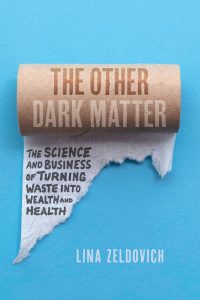Diving Into “The Other Dark Matter,” a guest post from Lina Zeldovich
In The Other Dark Matter: The Science and Business of Turning Waste into Wealth and Health, journalist Lina Zeldovich reveals how human excrement can be a life-saving, money-making resource—if we make better use of it. In the original piece below, adapted from her research, she explores how cities are learning to recycle their residents’ excrement.
I’m standing on an observation platform of DC Water, the sewage treatment facility of the US capital. To my left, there’s a centrifuge that sucks the water out of the incoming sludge. To my right, there are four massive biodigester tanks holding 3.8 million gallons of sewage each. And below me there are twenty-four colossal pressure cookers, steadily humming along. They are slowly cooking Washington, DC’s excrement.
Produced daily by over two million people, that output arrives from every house, apartment building, business, and historical landmark—Tyson’s Corner, the Smithsonian Institution, the Lincoln Memorial, and Capitol Hill. And the White House, of course. There’s some presidential poop percolating in those aerating tanks, along with the input from the Senate, the House of Representatives, the Pentagon, and the protestors chanting in front of the White House lawn. “That’s where all of us come together,” quips Bill Brower, a resource recovery engineer who is showing me around the plant. “And I’d like to thank all these people for their contributions.”
Why is DC Water cooking up this sewage soup? Because the planet has a human poop problem: Mother Earth simply can’t decompose our metabolic product fast and safe enough. With seven billion of us dishing out a pound of poo a day, where does it all go? The answer depends on where you live. For the residents of the less developed countries and places where flushing toilets can’t be built for environmental reasons, sewage management often means digging up latrines or heading for the bush. Often, these latrines are emptied by way of buckets and their content is dumped into the nearest river, where it contaminates the water for those living downstream, causing disease. In industrial societies, the wastewater is usually cleaned enough to be safely released back to nature, but the sludge remains a sticky issue and a hot potato. Sometimes it’s burned. Sometimes it’s dried and landfilled together with the trash. Sometimes it’s accumulated in “lagoons,” a euphemism for massive cesspits that hold tons of fermenting shit.
There’s also another problem, which scientists call a metabolic rift. Most of our farm produce, especially for people who live in colder climates, isn’t grown locally year-round. More often than not, it’s trucked, shipped, and flown from other locales. As it grows, that produce extracts the nutrients from the soil. As we eat the food and excrete our metabolic output, we redeposit the undigested nutrients—nitrogen, phosphorus, and potassium—in different places, transferring them from land into the water, where the waste effluent flows. Even when the wastewater is cleaned, it still retains a lot of fertilizing power, so when it pours into lakes, rivers, and the ocean, it overfertilizes them, causing toxic algae blooms and ruining ecosystems. That leads to gradually depleting farmlands that constantly need synthetic fertilizer and to over-enriched waterways, dying from overgrowth.
In the words of Canadian epidemiologist David Waltner-Toews, “we are taking all this biodiversity out of one ecosystem and creating these piles of shit somewhere else.” The stinky truth is that our industrial sewage plants have solved only one problem—ensuring that our excrement no longer endangers our health. But by solving the health problem, we’ve created another one: the redistribution of nutrients on the planet that ruins the nutritional balance of ecosystems, a ticking bomb that can massively damage the earth’s already fragile ecology.
Washington, DC, is one of the few cities that try to close that metabolic rift by keeping the nutrients on the land and returning them back to the soil. That’s what the setup is for. The massive cookers simmer sludge at 300°F and six times the atmospheric pressure to render it pathogen-free. Then the sewage stew is loaded into digesters where bacteria chew through it the same way they would do in nature, generating methane and black goo, akin to muddy riverbank slush. The plant burns methane to generate electricity and squeezes water from the muddy goo, which is later dried up into Grade A organic fertilizer, called BLOOM, safe enough to grow anything, including food.
DC Water isn’t the only sewage facility trying to close the metabolic rift. The Canadian company Lystek whips sewage into a fertilizing “humanure” smoothie that can be dispersed on fields because the process kills all the pathogens. Metropolitan Water Reclamation District of Greater Chicago, the entity responsible for treating the Windy City’s sewage, also converts biosolids into compost, used to grow flowers and vegetables. In New York City, a leading wastewater treatment plant pumps parts of the Big Apple’s output into massive digestor towers where bacteria chew through it, releasing methane, which will one day flow into Con Edison’s natural gas pipeline. Startups in Madagascar and Haiti are deploying similar tech on a smaller, local scale to provide sanitation for people who don’t have flushing toilets; instead, they rely on latrines that overflow during seasonal floods, spreading diseases.
So why hasn’t every Western city learned to recycle its residents’ excrement? The problem is our relationship with our own dark matter. We view it as ultimately disgusting, disease-spreading filth—and until this mindset persists most people wouldn’t care to transform their waste into valuable humanure. So the sooner we admit that our metabolic output is a cheap and fully renewable resource, the sooner we’ll close the metabolic rift. Scientists, engineers, and innovators have the means to make it happen. The rest of us just need to stop holding our noses and jump in.
Take a dive into The Other Dark Matter. You will never flush the same way again.

Lina Zeldovich is a writer and editor specializing in the journalism of solutions. Her work has appeared in the New York Times, Reader’s Digest, Smithsonian, Popular Science, Scientific American, Atlantic, and Newsweek, among many other popular outlets, and she has won awards from the Newswomen’s Club of New York, the Society of Professional Journalists Deadline Club, and the American Society of Journalists and Authors. An immigrant from the former Soviet Union, she lives in New York City and keeps a compost pile in her backyard.
The Other Dark Matter is available now! Find it on our website, online at any major booksellers, or at your local bookstore.
